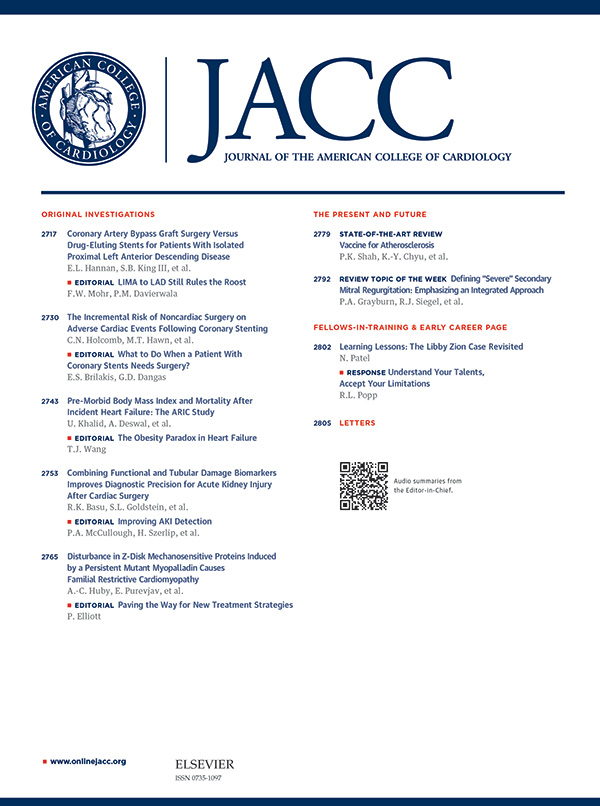Early Intra-Aortic Balloon Support for Heart Failure-Related Cardiogenic Shock: A Randomized Clinical Trial
IF 21.7
1区 医学
Q1 CARDIAC & CARDIOVASCULAR SYSTEMS
引用次数: 0
Abstract
Background
The impact of intra-aortic balloon pump (IABP) on survival and successful bridging to heart replacement therapies (HRT) in patients with heart failure–cardiogenic shock (HF-CS) remains unclear.Objectives
The purpose of this study was to evaluate the effect of early IABP use vs standard care on 60-day survival or successful bridging to HRT.Methods
In the multicenter, prospective Altshock-2 (Study on Early Intra-aortic Balloon Pump Placement in Acute Decompensated Heart Failure Complicated by Cardiogenic Shock), patients with Society for Cardiovascular Angiography and Interventions stage B, C, or D HF-CS and suitable for HRT were randomized to receive early IABP plus standard care (IABP group) or standard care (control group). The primary endpoint was survival or successful bridge to HRT at 60 days. Secondary endpoints included overall survival, maximum inotropic score, and maximum sequential organ failure assessment score.Results
In total, 53 patients were randomized to IABP and 48 to standard care. Patients were Society for Cardiovascular Angiography and Interventions stage B (28%, n = 28), C (57%, n = 56), and D (15%, n = 16). At the prespecified interim analysis, the trial was stopped because of futility. The primary endpoint was reached in 43 patients (81%) in the IABP group and 36 patients (75%) in the control group (HR: 0.72; 95% CI: 0.31-1.68; P = 0.45). A total of 37 patients (37%) underwent HRT within the 60-day follow-up. Four patients were escalated in the study group (7.5%) vs 2 in the control group (4.2%). Additionally, 6 patients (13%) initially assigned to standard care crossed over to IABP. Complications were comparable between groups.Conclusions
Routine early IABP plus standard care, compared with standard care, did not significantly improve survival or successful bridging to HRT in patients with HF-CS. (Study on Early Intra-aortic Balloon Pump Placement in Acute Decompensated Heart Failure Complicated by Cardiogenic Shock [Altshock-2]; NCT04369573)

求助全文
约1分钟内获得全文
求助全文
来源期刊
CiteScore
42.70
自引率
3.30%
发文量
5097
审稿时长
2-4 weeks
期刊介绍:
The Journal of the American College of Cardiology (JACC) publishes peer-reviewed articles highlighting all aspects of cardiovascular disease, including original clinical studies, experimental investigations with clear clinical relevance, state-of-the-art papers and viewpoints.
Content Profile:
-Original Investigations
-JACC State-of-the-Art Reviews
-JACC Review Topics of the Week
-Guidelines & Clinical Documents
-JACC Guideline Comparisons
-JACC Scientific Expert Panels
-Cardiovascular Medicine & Society
-Editorial Comments (accompanying every Original Investigation)
-Research Letters
-Fellows-in-Training/Early Career Professional Pages
-Editor’s Pages from the Editor-in-Chief or other invited thought leaders

 求助内容:
求助内容: 应助结果提醒方式:
应助结果提醒方式:


